Organized for the first Cairns Cup, this exhibition contains highlights related to women’s chess from the collection of the World Chess Hall of Fame (WCHOF). Among the artifacts are objects related to important moments in women’s chess history, including Women’s World Chess Championships, Women’s Chess Olympiads, and many national championships held at the Saint Louis Chess Club (STLCC). Several of the artifacts are related to competitors in the tournament, including Women’s World Chess Champion Alexandra Kosteniuk and U.S. Women’s Chess Champions Irina Krush and Anna Zatonskih.
Inspired by its mission to further promote the game of chess to women and girls, the STLCC created the Cairns Cup, a nine-round classical chess tournament that brings together one of the strongest international fields ever assembled in women’s chess with one of the largest prize funds for an all-female tournament. The tournament is named in honor of STLCC co-founder Dr. Jeanne Sinquefield, whose maiden name is Cairns. In addition to being a co-founder of the Club, Jeanne also played an instrumental role in creating the Boy Scouts of America Chess Merit Badge, which has been earned by over 170,000 scouts.
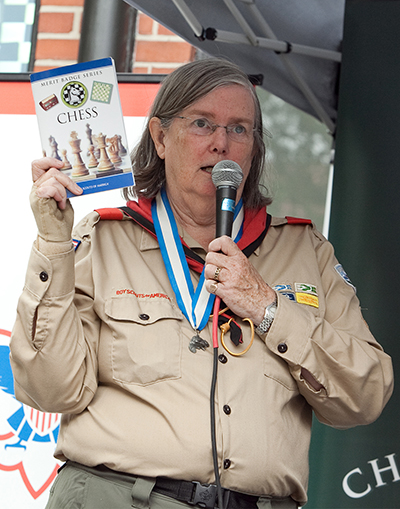
Lori Mattler of Lace Photography
Jeanne Sinquefield at the Scouts BSA Chess Merit Badge Launch
September 10, 2011
11 x 14 in.
Photograph
Collection of the World Chess Hall of Fame
Dr. Jeanne Sinquefield appears at the launch of the Scouts BSA (BSA) chess merit badge, which coincided with the opening of the World Chess Hall of Fame. Astronaut Greg Chamitoff, who had played chess against players on earth while stationed on the International Space Station, attended the event at her invitation and presented the scouts with their chess merit badges.
Involved with the Scouts BSA for 30 years, Jeanne Sinquefield is passionate about the organization and the benefits that it provides to participants. When she learned that there had been discussions of creating a chess merit badge for 40 years, but it had not yet been realized, she dedicated herself to making it a reality. Through her friend Christina Gables, the Troop Committee Chair for Troop 400 of the Western Los Angeles Council, she was able to contact the National Executive Board and worked with Janice Downey, Senior Program Innovation Manager, to begin the process of creating the badge. Ralph Bowman, Jerry Nash, and US Chess helped develop the requirements, which include learning the rules of the game as well as its history, benefits, and etiquette, among other tasks. Scouts must not only learn how to play the game, but also teach it to another individual, ensuring that the benefits of chess are shared with others.

Sports Illustrated, Vol. 15, No. 6
August 7, 1961
11 x 8 ½ in.
Paper
Collection of the World Chess Hall of Fame
John G. Zimmerman/Sports Illustrated Classic/Getty Images
Lisa Lane, the 1959 and 1966 U.S. Women’s Chess Champion, learned to play chess at age 19. She quickly rose to the top ranks of American women’s chess, competing in the U.S. Women’s Chess Championship only two years after taking up chess. However, Lane stopped competing in chess tournaments at age 30, only briefly returning to the world of chess in 1971 to publicly play a game against an IBM chess computer, which she won. Of the computer she stated, “It did not...appear to resent losing to a woman as do many human male players.”
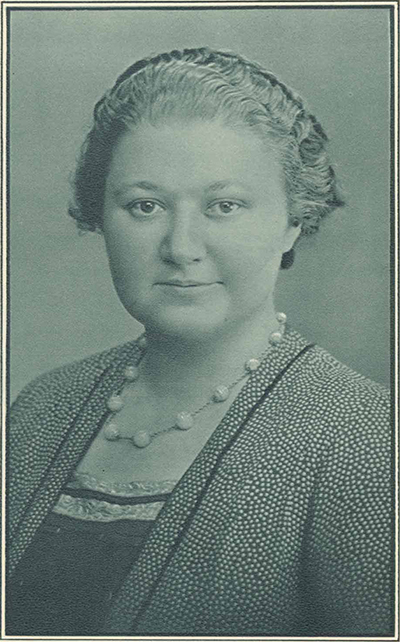
Studio Herbert Vandyk, Londres
Vera Menchik, from Le Monde des Echecs
February 1933
9 ½ x 6 ¼ in.
Paper
Collection of the World Chess Hall of Fame, gift of John Donaldson
Vera Menchik, the world’s first women’s chess champion, was born in Russia in 1906, learned chess at age nine, and moved to England as a teenager in 1921. Over the course of her career, she competed for Russia, Czechoslovakia, and England. She became the first Women’s World Champion in 1927 and successfully defended her title six times over the next 17 years. She lost only one game over the course of these seven championship tournaments. Menchik’s career was cut tragically short when she, her two sisters, and their mother were killed in a V-1 rocket bombing raid at their South London home in June 1944. The Women’s Olympiad trophy is known as the Vera Menchik Cup in her honor.

Mark Rabkin
GM Maya Chiburdandize
Date unknown
7 ³⁄₁₆ x 4 ¹¹⁄₁₆ in.
Photograph
Collection of the World Chess Hall of Fame
GM Maya Chiburdanidze’s introspective, exceptional play earned her a place at the top of women’s chess from a young age. In 1977, she won the U.S.S.R. Women’s Chess Championship. The following year she defeated GM Nona Gaprindashvili in the Women’s World Chess Championship, becoming the new World Champion at age seventeen. Chiburdanidze would defend her title four times, finally losing it in 1991 to GM Xie Jun. A pioneer in women’s chess, in 1984 Chiburdanidze became only the second woman to earn the title of grandmaster. Additionally, she was a member of the Soviet and later Georgian women’s teams that dominated the Women’s Chess Olympiads through the 1980s and 1990s, winning nine team gold medals and four individual gold medals on Board 1.

Photographer unknown
GM Nona Gaprindashvili and WGM Alla Kushnir at the 1972 Women’s World Chess Championship, Riga, Latvia
1972
5 ½ x 3 ⅝ in.
Photograph
Collection of the World Chess Hall of Fame
Five-time winner of the Women’s World Chess Championship, Nona Gaprindashvili, held the title from 1962 to 1978, when she lost to Maya Chiburdanidze. Gaprindashvili’s accomplishments were instrumental in proving that women could compete with men on the international stage. In 1978, she was the first woman to be awarded the title of grandmaster by the World Chess Federation (Federation Internationale des Échecs or FIDE). She earned this distinction for her impressive performance in the 1977 Lone Pine International Tournament, where she shared first place.
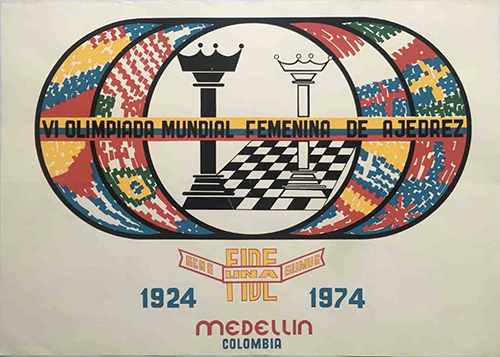
Poster from the Sixth Women’s Chess Olympiad, Medellin, Colombia
September 15–October 7, 1974
19 ⅝ x 27 ¾ in.
Paper
Collection of the World Chess Hall of Fame
The sixth Women’s Chess Olympiad, which was held in Medellin, Colombia, marked the last time that the women’s competition was held separately from the open section of the Olympiad, in which people of any gender may compete. However, this is not the only noteworthy fact about this Olympiad, the first held outside Europe and even today one of only two hosted in the Americas. It is truly unique because in over 100 open and women’s competitions, it is the only Olympiad that not only finished in a tie for first but also had a playoff match between the Soviet Union and Romania (the U.S.S.R. won). The American team of Mona May Karff, Ruth Herstein, and Ruth Haring placed fourth in the B group.

Chess Life, Vol. 47, No. 11
November 1992
10 ¾ x 8 ¼ in.
Paper
Collection of the World Chess Hall of Fame, gift of Bill Merrell
Chess Life cover used with permission of US Chess
Grandmaster (GM) Judit, International Master Sofia, and GM Susan Polgar pose on the cover of this colorful issue of Chess Life. Inside, the magazine details the events of the United States Chessathon, a charity event in which the three sisters appeared. Judit took second in the 1992 U.S. Chess International (Samuel Reshevsky Memorial), behind GM Julio Granda Zuniga. There have been several famous sister pairs in chess (the Muzychuk and Kosintseva sisters the most prominent), but no group of three as distinguished as the Polgars, with Judit the highest-rated women in the history of the game and the only female Candidate for the World Chess Championship, Susan a Women’s World Chess Champion, and Sofia achieving one of the highest tournament performance ratings and having a peak FIDE rating of 2505.
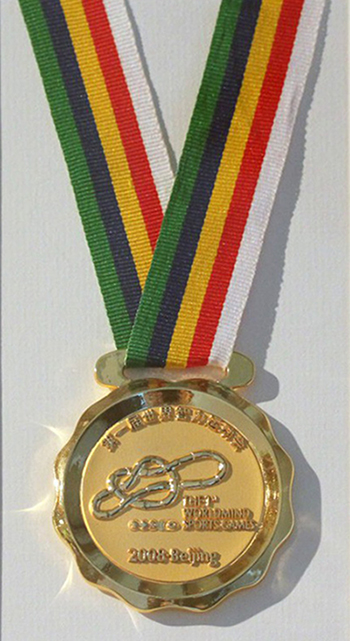
GM Alexandra Kosteniuk’s Gold Medal from the 2008 Mind Sports Games, Beijing, China
2008
2 ¾ in. dia.
Metal and cloth
Collection of the World Chess Hall of Fame
The 2008 Mind Sports Games, which included chess, bridge, draughts (checkers), go and xiangqi (Chinese chess), was the first competition of its kind. It was held in Beijing, China, as were the Olympics and Paralympics the same year. The World Chess Federation (Federation Internationale des Échecs or FIDE) organized the chess section of the program which consisted of ten separate events for men and women as individuals and teams, including mixed pairs. All events were held at either blitz or rapid time controls. The newly-crowned Women’s World Chess Champion, Alexandra Kosteniuk of Russia, won the gold medal in the women’s blitz portion of the competition ahead of former Women’s World Chess Champion Antoaneta Stefanova of Bulgaria and future Women’s World Chess Champion Hou Yifan of China.

Poster from the 1991 Women’s World Chess Championship Match, Manila, Philippines
September 25–November 2, 1991
20 ¾ x 14 ¾ in.
Paper
Collection of the World Chess Hall of Fame
The Women’s World Championship match between Grandmaster (GM) Xie Jun of China and GM Maya Chiburdanidze of Georgia (then a part of the Soviet Union) marked an important moment in chess history. Xie ended Chiburdanidze’s 13-year reign by the score of 8 ½-6 ½. At age 21, Xie became the first Chinese women’s world chess champion (there are now six) and the first champion in the post-World War II era not from the Soviet Union. Chiburdanidze’s defeat ended an almost 30-year run at the top by Georgian players (Nona Gaprindashvili 1962-1978 and Chiburdanidze 1978-1991). The poster claims this was the first women’s title match held outside of the Soviet Union; however, the earlier 1986 match between Chiburdanidze and Woman Grandmaster Elena Akhmilovskaya Donaldson was played in Sofia, Bulgaria.

Bill Hook
GM Xie Jun at the 1992 Chess Olympiad, Manila, Philippines
1992
6 x 4 in.
Photograph
Collection of the World Chess Hall of Fame, gift of the U.S. Chess Center
Women’s World Champion Xie Jun of China won a pair of bronze medals in the women’s section of the Manila Chess Olympiad, which was held in the summer of 1992. China placed third in the team competition behind Georgia and Ukraine, and Xie Jun was the third best first board (10 out of 13) behind Women’s World Chess Champion Maya Chiburdanidze and International Master Alisa Galliamova. One of the most successful olympiad players of all time, Xie scored 67 points from 94 games (+50, =34, -10) in eight of the events, winning seven team medals (3-1-3), and five individual medals(0-2-3). Amazingly, since 1990, China has missed the podium only once (2008) in 20 Women’s Chess Olympiads.
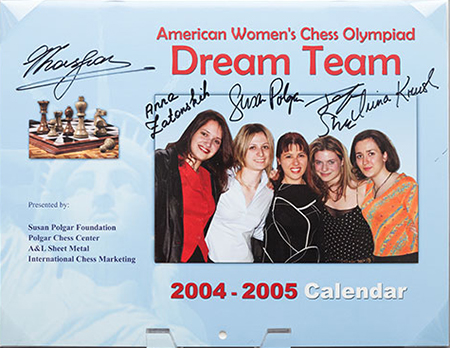
Dream Team Calendar from the 2004 Chess Olympiad, Calvià, Majorca, Spain
2004
8 ½ x 11 in.
Paper
Collection of the World Chess Hall of Fame, gift of John Donaldson
The U.S. women’s team made history at the 2004 Women’s Chess Olympiad held in Calvia, Spain, by finishing second as a team. It was the first time that the United States had won team medals in the Women’s Chess Olympiad, a team competition in which the best players around the world play as teams representing their countries. Grandmaster (GM) Susan Polgar, who came out of a seven-year retirement to score an undefeated 10 ½ out of 14 (2622 performance), the best individual result of the event, led the team. Pictured (l-r) are International Master (IM) Anna Zatonskih, IM Rusa Goletiani, GM Susan Polgar, Woman Grandmaster Jennifer Shahade, and GM Irina Krush. Goletiani trained with the team but did not play in Calvia. The U.S. women’s team was sponsored by the Kasparov Chess Foundation and the US Chess Federation, with FIDE Master Paul Truong serving as captain, FIDE Senior Trainer Michael Khodarkovsky as coach, and GM Alexander Chernin as chief theoretician.

Lennart Ootes
IM Nazi Paikidze vs. WIM Annie Wang during Round 9 of the 2018 U.S. Women’s Chess Championship
April 27, 2018
11 x 14 in.
Photograph
Collection of the World Chess Hall of Fame
International Master (IM) Nazi Paikidze studies the board in this photo from the 2018 U.S. Women’s Chess Championship. Paikidze has won the competition twice (2016 and 2018) and placed second twice. The 12-player round robin tournament was arguably the strongest-ever U.S. Women’s Chess Championship. The competitors included experienced veteran players like U.S. Women’s Chess Champions Irina Krush and Anna Zatonskih as well as rising young stars like 15-year-old Annie Wang and 16-year-old Jennifer Yu.

Austin Fuller
WIM Carissa Yip and WGM Jennifer Yu Shake Hands before Round 9 of the 2018 Girls’ Junior Chess Championship
July 21, 2018
9 ½ x 14 in.
Photograph
Collection of the World Chess Hall of Fame
Ten years ago, the number of American-born women who had achieved the title of master could be counted on two hands. That mark has since doubled thanks to rising young talent. Jennifer Yu of Virginia and Carissa Yip of Massachusetts are two of these stars. Last fall, Yu made a sensational Olympiad debut at Batumi, Georgia, winning an individual bronze medal and making her first international master norm. In 2015, Yip broke the record for the youngest female master by crossing 2200 at age 11. Here, the two are pictured before their last-round game in the 2018 U.S. Girls’ Junior Championship held at the Saint Louis Chess Club, which ended in a draw. Yip won the title and Yu tied for second.

Lennart Ootes
John Urschel vs. Rachael Li at the 2017 Ultimate Moves Match
August 19, 2017
9 ½ x 14 in.
Photograph
Collection of the World Chess Hall of Fame
This picture emphasizes that skill rather than age, size, or gender is what counts in chess. Here, former National Football League player (Baltimore Ravens) and mathematician (MIT) John Urschel is playing against seven-year-old Rachael Li of Plano, Texas, as part of the 2017 Ultimate Moves Match held at the Saint Louis Chess Club as a fun side event accompanying the annual Sinquefield Cup and Saint Louis Rapid & Blitz tournaments. Urschel, a US Chess-rated class B player (1723) was defeated by Li, who in January 2019, with a rating of 2079, is the top-rated eight-year-old player—girl or boy—in the United States.
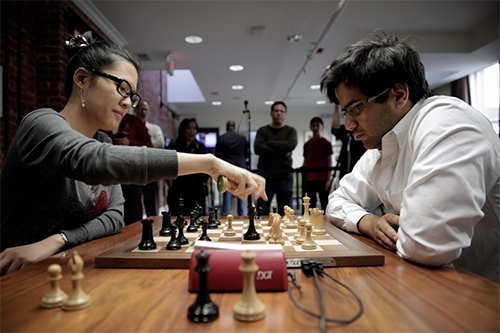
Spectrum Studios
GM Hou Yifan and GM Parimarjan Negi at the 2015 Showdown in Saint Louis
November 15, 2015
9 ½ x 14 in.
Photograph
Collection of the World Chess Hall of Fame
Three-time Women’s World Chess Champion Hou Yifan of China is only the third woman to break into the list of the top 100 players in the world. Hou was only 14 when she earned the grandmaster title and 16 years old when she earned her first women’s world chess championship— making her the youngest woman to earn either title. Here she plays against Grandmaster (GM) Parimarjan Negi of India during the 2015 Showdown in Saint Louis, a pair of exhibition matches that included Hou and Negi as well as top American stars GMs Fabiano Caruana and Hikaru Nakamura. The pairs played a round of Basque chess (a chess variant where players play their opponents in two simultaneous games against one another—one with black and one with white), four rounds of rapid and Chess960 (a chess variant in which the positions of chess pieces on the first rank are randomized), and eight rounds of blitz. Hou won the match, which had a $30,000 first prize.















